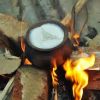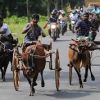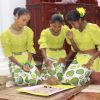සිංහල දෙමළ අළුත් අවුරුද්ද
Sinhala Aluth Avurudda was celebrated in the Kandyan Kingdom as a national festival under the patronage of the kings. This was done in keeping with the rituals. The astrologers worked out Nekath (auspicious times) to perform the rituals in order to bring about prosperity and happiness to the people and country.
Sinhala Avurudda dawns when the Sun moves from Meena Rashiya to Mesha Rashiya completing a cycle of a twelve-month period. The transition time know as "Sanskranthi" takes place on April 13 or 14. It is during this period that some of the rituals are performed to mark this important event of the year.
The dawn of Aluth Avurudda signifies social customs and good behaviour of the Sinhala people. The majority of the people being farmers, after their major harvest "Maha" of the year is over, celebrate the occasion in the form of giving thanks. The customs and rituals portray the beliefs and thinking of the people whose life is centred around agriculture.
Rituals connected with Aluth Avurudda commence with bathing on the last day of the old year (Parana Avurudda) and viewing the moon on the same night. In the village temple, the pealing of the bell accompanied with the beating of drums (Hewisi) make the people aware of the times to perform different rituals.
The custom of offering betel to parents and elders demonstrate the act of paying gratitude. The children in turn receive blessings from parents moulded according to Buddhist thought. The sense of goodwill and friendship among relations and friends is also seen during the festival time.
Most of the rituals are linked with the village temple. People visit the temple during the time of "Sanskranthi" the transitional period when they believe that there are no auspicious times (Nekath) to engage themselves in different tasks.
This time is called "Nonagathe" during which people devote their time in performing religious practices. It is for this reason it is also called "Punniya Kale" when people stop all their activities, and visit the temple to accrue merit and get their blessings from the monks.
The belief in the arrival of Avurudu Kumaraya attired in princely clothes gives the idea of the dawn of the New Year. The prince comes in a horse-drawn carriage travelling in a fixed direction. The dress he wears varies in colour from year to year in keeping with the colour meant for the particular year.
The time is opportune for the women folk to commence their work at their respective homes. They begin by facing the correct direction and light the hearth to prepare the traditional Kiribath. Prior to this, milk is boiled in a newly earthen pot symbolising prosperity when the milk spills over from all sides of the pot.
Another meal is cooked along with a curry "Hath Maluwa" that has seven different flavours which is considered as a delicacy prepared during New Year time. Other sweetmeats specially prepared for the festive season are made in advance to serve the visitors who d










